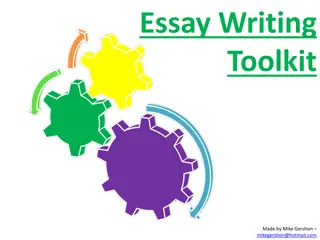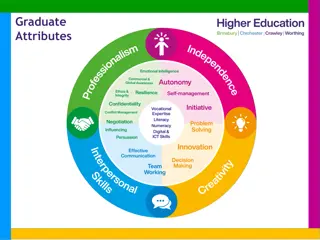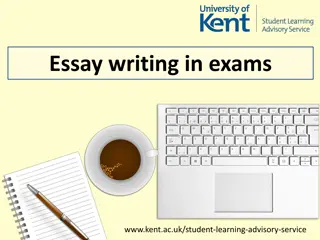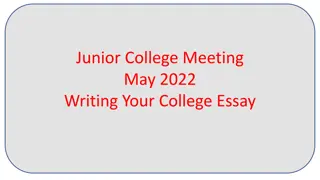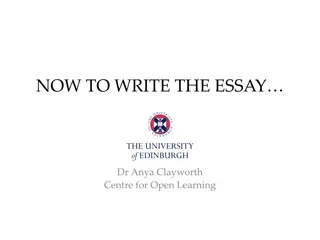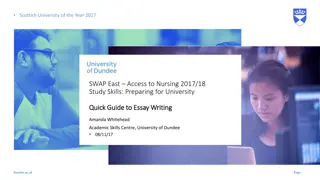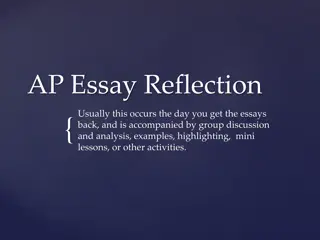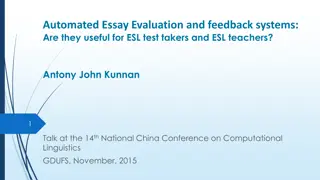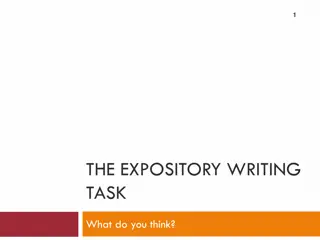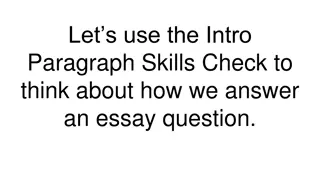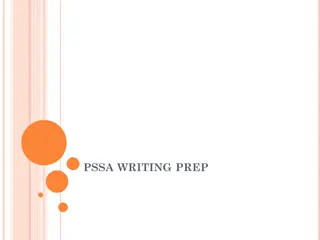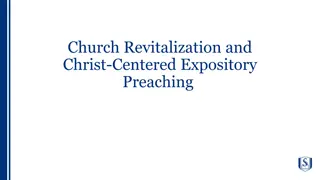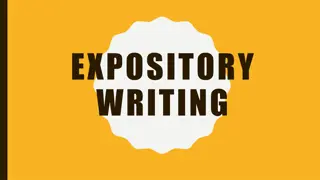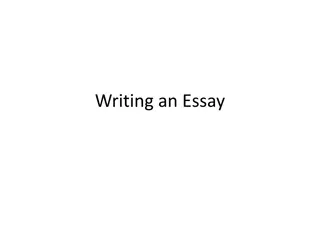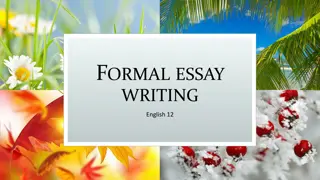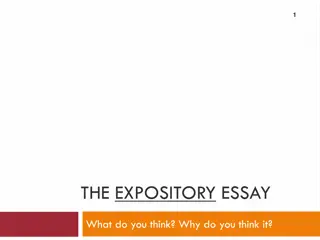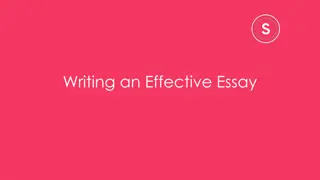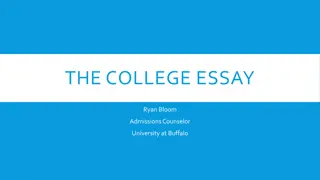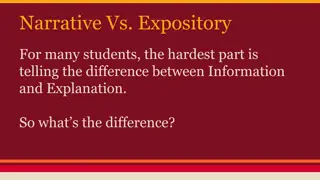Mastering the Art of Expository Essay Writing
The expository essay is a powerful genre that involves investigating ideas, evaluating evidence, and presenting arguments clearly. Key components such as the thesis statement, topic sentences, and transitions are crucial for crafting a logical and compelling expository essay. Understanding these elements is essential for creating informative and well-structured pieces.
Download Presentation

Please find below an Image/Link to download the presentation.
The content on the website is provided AS IS for your information and personal use only. It may not be sold, licensed, or shared on other websites without obtaining consent from the author.If you encounter any issues during the download, it is possible that the publisher has removed the file from their server.
You are allowed to download the files provided on this website for personal or commercial use, subject to the condition that they are used lawfully. All files are the property of their respective owners.
The content on the website is provided AS IS for your information and personal use only. It may not be sold, licensed, or shared on other websites without obtaining consent from the author.
E N D
Presentation Transcript
Informative/Expository Essay 7.W.2Write informative/explanatory texts to examine and convey complex ideas and information clearly and accurately through the effective selection, organization, and analysis of content. Write routinely over extended time frames (time for research, reflection, and revision) and shorter time frames (a single sitting or a day or two) for a range of discipline-specific tasks, purposes, and audiences. (7.W.10)
What is an expository essay? The expository essay is a genre of essay that requires investigate an idea, evaluate evidence, expand on the idea, and set forth an argument concerning that idea in a clear and concise manner.
Key Components (no notes) Expository Writing defines and explains Introductory or lead paragraph invites the reader to explore the topic Thesis statement reveals overall purpose of the writing Body consists of three or more points, descriptions, or examples Concluding paragraph restates the thesis and offers the reader the opportunity to reflect further on the topic
Expository Essay The expository essay must be complete and logical, leaving no doubt as to its intent or argument.
Topic Sentence A topic sentence tells the main idea of a paragraph. Every paragraph should have a topic sentence. A topic sentence (usually at the beginning of a paragraph) tells the reader what to expect.
Thesis A clear, concise, and defined thesis statement that occurs in the first paragraph of the essay. Should be appropriately narrowed by the guide lines set forth in the assignment Your thesis statement should be specific it should cover only what you will discuss in your paper and should be supported with specific evidence.
Transitions Clear and logical transitions between the introduction, body, and conclusion Transitions are the mortar that holds the foundation of the essay together. Without logical progression of thought, the reader is unable to follow the essay s argument, and the structure will collapse.
Evidential Support (expert quote) factual, logical, statistical, or anecdotal Gives substance, authority and legitimacy to the writers point of view initially previewed in Thesis
Analysis in Body Paragraphs Should be limited to the exposition of evidential support and how it relates to specific point This will allow for clarity and direction throughout the essay. What is more, such conciseness creates an ease of readability for one s audience. It is important to note that the analysis each paragraph in the body of the essay must have some logical connection to the thesis statement in the opening paragraph.
A conclusion that does not simply restate the thesis readdresses it in light of the evidence provided. This is the portion of the essay that will leave the most immediate impression on the mind of the reader. Therefore, it must be effective and logical. Do not introduce any new information into the conclusion; rather, synthesize and come to a conclusion concerning the information presented in the body of the essay.
Techniques Pick evidence that clearly and directly proves your point Paraphrase relevant facts or stories (Shorten quotes and stories) Organization varies: chronological, order of importance, or order of familiarity Address separate aspects of the topic in each paragraph don t intermix points Paragraphs elaborate on key components no rhetorical questions stay with thesis Specific details and examples support the main idea of each paragraph Proofread and delete unrelated or unnecessary information
DO and DO NOT DO stay in the thesis order DO keep analysis to evidence DO keep quotes and titles at a reasonable lengths (use ellipses ) DO use transitions from one point to another DO wrap up thoughts in conclusion. DO NOT use first person (I) DO NOT use random quotes that initially confuse the reader DO NOT start analysis with, I chose this quote because or This quote means DO NOT use casual words (dumb)
I Thesis Specific and Narrowed to the topic II Point one A. Citation of evidence B. Analysis (So what? how does this relate to the point?) C. Final thought transition to second point III Point two A. Citation of evidence B. Analysis (So what? how does this relate to the point?) C. Final thought transition to third point OR conclusion IV Conclusion Synthesize information in restated thesis
I There are several reasons why children should not take unnecessary risk. II Children are too young to make a life threatening decision a. Citation: Parenthood requires invoking maturity where child lacks b. Parents protect their children every day in mundane situations c. Risky situations require even more protection III Children are mentally unprepared for unnecessary risks a. Citation: despite experience, children are still mentally unprepared b. Scientific studies show the brain does not fully develop until 25 years old c. Panic Could turn a dangerous situation into a hazardous situation IV Xxxxxxxxxxxx a. Citation: X.xxx b. Xxxxxxxxxxx c. Xxxxxxxx V Children are too young and lack maturity to make risky decisions that could cost their life.
References https://owl.english.purdue.edu/owl/resource/685/02/

 undefined
undefined





